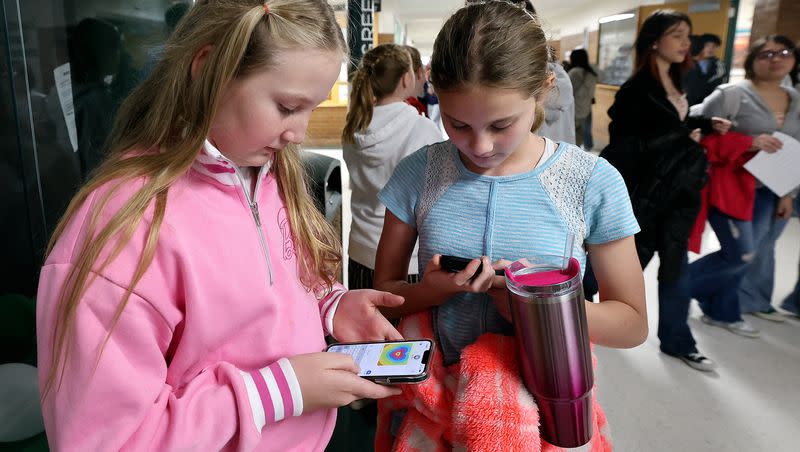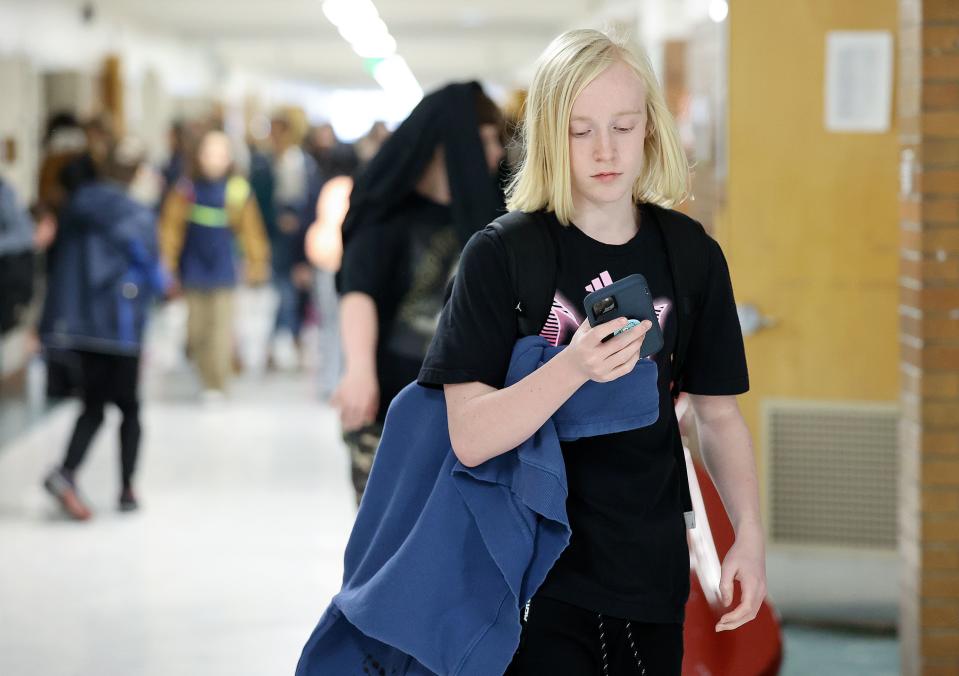Gov. Cox to public schools: Students should shelve cellphones while at school

- Oops!Something went wrong.Please try again later.
Evergreen Junior High’s cellphone policy was in place before principal Ryan Shaw was hired to lead the Granite School District school two years ago.
“It’s just something that’s kind of in our culture,” said Shaw, who has also been a high school assistant principal and classroom teacher.
“Every school is different. It works at our school. It works really well at our school. We have good community buy-in and our students buy into it. So I’m just fortunate that it worked,” said Shaw.
Utah Gov. Spencer Cox lifted up the Millcreek school as an example where cellphone restrictions have been successful. He wants all Utah public schools to follow suit.
“We all know that cellphones are a distraction and when we put phones away we can actually focus and study,” Cox said in a press release Wednesday.
“Cellphone-free learning environments will help our teachers teach and our students learn. We want to give our schools every opportunity to succeed and so I hope our local school districts and charter schools will join me in this effort to keep phones in backpacks or lockers during class time,” he said.
Cox raised the issue of students’ cellphone use during the PBS Utah Governor’s Monthly News Conference in December.
Related

On Wednesday, he announced that he has sent letters to school principals, charter school leaders, school community councils and the Utah State Board of Education urging their support in removing cellphones from schools during class time, citing the negative impacts of social media.
State school board rule addresses the use of electronic devices in schools. It directs school districts and charter boards to adopt an electronic device policy that prohibits the use of electronic devices in ways that “significantly impair academic excellence; bully, humiliate, harass or intimidate school-related individuals ... or violate local, state, or federal laws.” The board’s policy is dated December 2023.
Democratic gubernatorial candidate Rep. Brian King, D-Salt Lake City, said he does not believe in a “one-size-fits-all approach to this situation.”
King, in a statement, said in part: “No one is in a better position to effectively address those challenges than our teachers, school administrators and the parents of our students. As they communicate with each other, I encourage them and trust they will come up with a solution that works best for their particular schools.”
Carson Jorgensen, a Republican challenger for governor, said he “doesn’t disagree” with the goal of fewer disruptions in classrooms and curbing the harmful effects of social media.
“That said, I believe these issues are better resolved at a local level, between parents and teachers as much as possible. This is a legitimate issue that has been around for a while. I can’t help but be a little amused at how many ‘legitimate issues’ have become more urgent since an election year rolled around,” Jorgensen said.
Sen. Mitt Romney, R-Utah, (@SenatorRomney), tweeted his support on X:
“Nearly 97% of 11-17 year olds with cellphones are using them during the school day for non-educational purposes, which can negatively affect students’ focus and academic performance. I commend @GovCox’s efforts to improve learning environments for Utah’s students.”
Evergreen Junior High serves students in grades 6, 7 and 8. A meeting is held each year with incoming sixth graders and their parents to explain the cellphone policy and the rationale behind it along with other school rules and procedures, Shaw said.
“We’re not checking kids as they come through the door, obviously. The expectation is that they’re either put in their lockers or their backpacks. They’re not to be used at all during the school day,” Shaw said.
If a parent needs to reach their child during the school day, they are asked to call the school office and they’ll be summoned from their class “immediately if needed or as quickly as we can,” he said.
“There’s always things that come up, right?”
Cox’s statement also highlighted Delta High School in Millard School District as a “cellphone-free” school.
Students put their phones in a clear pocket that hangs in front of the classroom.
Assistant principal Jared Christensen said, “It was a battle to begin with, but it has been so worth it. Students and parents have all adapted, our teachers are happier and learning has increased.”
Cox acknowledges that many schools in Utah have already moved forward with school-wide cellphone policies to limit student access and have shared experiences that are supported by compelling national data.
“They have found that learning improves, distractions are fewer, student engagement increases and opportunities for human connection are fostered when phones are kept in backpacks or lockers,” the press release states.
Shaw agrees that there is more face-to-face engagement among students at Evergreen Junior High than in other schools he has served in as an administrator.
“There’s not that ‘I’m just locked in to my cellphone and I’m scrolling around and on TikTok and doing that.’ It’s that interactive piece. They have that social piece that is huge and I’m super happy about that,” Shaw said.

